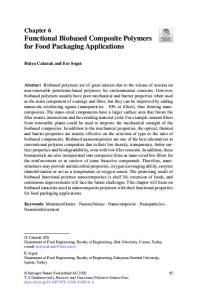Functionalization of polymers and nanomaterials for water treatment, food packaging, textile and biomedical applications
- PDF / 3,750,215 Bytes
- 29 Pages / 595.276 x 790.866 pts Page_size
- 70 Downloads / 366 Views
REVIEW
Functionalization of polymers and nanomaterials for water treatment, food packaging, textile and biomedical applications: a review Pooyan Makvandi1,15 · Sidra Iftekhar2 · Fabio Pizzetti3 · Atefeh Zarepour4 · Ehsan Nazarzadeh Zare5 · Milad Ashrafizadeh6 · Tarun Agarwal7 · Vinod V. T. Padil8 · Reza Mohammadinejad9 · Mika Sillanpaa10,11 · Tapas Kumar Maiti7 · Giuseppe Perale12,13 · Ali Zarrabi14 · Filippo Rossi3 Received: 11 August 2020 / Accepted: 27 August 2020 © The Author(s) 2020
Abstract The inert nature of most commercial polymers and nanomaterials results in limitations of applications in various industrial fields. This can be solved by surface modifications to improve physicochemical and biological properties, such as adhesion, printability, wetting and biocompatibility. Polymer functionalization allows to graft specific moieties and conjugate molecules that improve material performances. In the last decades, several approaches have been designed in the industry and academia to graft functional groups on surfaces. Here, we review surface decoration of polymers and nanomaterials, with focus on major industrial applications in the medical field, textile industry, water treatment and food packaging. We discuss the advantages and challenges of polymer functionalization. More knowledge is needed on the biology behind cell–polymer interactions, nanosafety and manufacturing at the industrial scale. Keywords Antibacterial · Drug delivery · Functional polymers · Functionalization · Surface modification Pooyan Makvandi, Sidra Iftekhar, Fabio Pizzetti and Atefeh Zarepour have contributed equally to this work. * Pooyan Makvandi [email protected] * Ali Zarrabi [email protected] * Filippo Rossi [email protected] 1
2
3
Istituto Italiano di Tecnologia, Centre for MicroBioRobotics, Viale Rinaldo Piaggio 34, 56025 Pontedera, Pisa, Italy Department of Environmental Engineering, University of Engineering and Technology Taxila, Taxila 47050, Pakistan Department of Chemistry, Materials and Chemical Engineering, Politecnico di Milano Technical University, 20133 Milan, Italy
4
Department of Biotechnology, Faculty of Biological Science and Technology, University of Isfahan, Isfahan, Iran
5
School of Chemistry, Damghan University, 36716‑41167 Damghan, Iran
6
Department of Basic Science, Faculty of Veterinary Medicine, University of Tabriz, Tabriz, Iran
7
Department of Biotechnology, Indian Institute of Technology, Kharagpur, Kharagpur 721302, India
8
Department of Nanomaterials in Natural Sciences, Institute for Nanomaterials, Advanced Technologies and Innovation (CXI), Technical University of Liberec (TUL), Studentská 1402/2, Liberec, Czech Republic
9
Pharmaceutics Research Center, Institute of Neuropharmacology, Kerman University of Medical Sciences, Kerman, Iran
10
Faculty of Environment and Chemical Engineering, Duy Tan University, Da Nang 550000, Vietnam
11
School of Civil Engineering and Surveying, Faculty of Health, Engineering and Sciences, University o
Data Loading...











